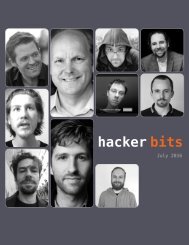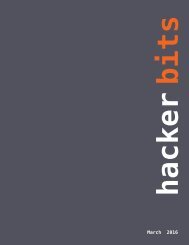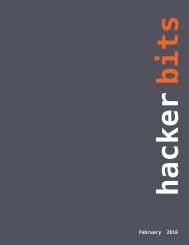Hacker Bits, August 2016
HACKER BITS is the monthly magazine that gives you the hottest technology stories crowdsourced by the readers of Hacker News. We select from the top voted stories and publish them in an easy-to-read magazine format. Get HACKER BITS delivered to your inbox every month! For more, visit https://hackerbits.com/2016-08.
HACKER BITS is the monthly magazine that gives you the hottest technology stories crowdsourced by the readers of Hacker News. We select from the top voted stories and publish them in an easy-to-read magazine format.
Get HACKER BITS delivered to your inbox every month! For more, visit https://hackerbits.com/2016-08.
Create successful ePaper yourself
Turn your PDF publications into a flip-book with our unique Google optimized e-Paper software.
Clarke’s third law — “Any sufficiently<br />
advanced technology is indistinguishable<br />
from magic.”<br />
• (3) Moore’s law — “The observation<br />
that the number<br />
of transistors in a dense<br />
integrated circuit doubles<br />
approximately every two<br />
years.”<br />
• (3) Metcalfe's Law — “The<br />
value of a telecommunications<br />
network is proportional<br />
to the square of the<br />
number of connected users<br />
of the system…Within the<br />
context of social networks,<br />
many, including Metcalfe<br />
himself, have proposed<br />
modified models using (n ×<br />
log n) proportionality rather<br />
than n^2 proportionality.”<br />
• (3) Clarke’s third law — “Any<br />
sufficiently advanced technology<br />
is indistinguishable<br />
from magic.”<br />
Business<br />
• (1) Minimum viable product<br />
— “A product with just<br />
enough features to gather<br />
validated learning about the<br />
product and its continued<br />
development.” (Related: perfect<br />
is the enemy of good)<br />
• (2) Capital allocation options<br />
— “Five capital allocation<br />
choices CEOs have: 1)<br />
invest in existing operations;<br />
2) acquire other businesses;<br />
3) issue dividends; 4) pay<br />
down debt; 5) repurchase<br />
stock. Along with this, they<br />
have three means of generating<br />
capital: 1) internal/<br />
operational cash flow; 2)<br />
debt issuance; 3) equity<br />
issuance.”<br />
• (3) Luck surface area — “When<br />
you do something you’re excited<br />
about you will naturally<br />
pull others into your orbit.<br />
And the more people with<br />
whom you share your passion,<br />
the more who will be<br />
pulled into your orbit.”<br />
• (3) Hunting elephants vs<br />
flies — “Salespeople sometimes<br />
refer to ‘elephants’,<br />
‘deers’ and ‘rabbits’ when<br />
they talk about the first<br />
three categories of customers.<br />
To extend the metaphor<br />
to the 4th and 5th type of<br />
customer, let’s call them<br />
‘mice” and “flies’. So how can<br />
you hunt 1,000 elephants,<br />
10,000 deer, 100,000<br />
rabbits, 1,000,000 mice or<br />
10,000,000 flies?” (Related:<br />
brontosaurus, whale, and<br />
microbe)<br />
• (3) Secrets — “Every one of<br />
today’s most famous and<br />
familiar ideas was once<br />
unknown and unsuspected…There<br />
are many more<br />
secrets left to find, but they<br />
will yield only to relentless<br />
searchers.”<br />
• (3) Strategic acquisition<br />
vs financial acquisition vs<br />
acquihire — Different motivations<br />
for an acquiring<br />
company typically have<br />
significantly different valuation<br />
models. (Related: rollup<br />
— “a technique used by<br />
investors (commonly private<br />
equity firms) where multiple<br />
small companies in the same<br />
market are acquired and<br />
merged.”, P/E-driven acquisitions,<br />
auction)<br />
Influencing<br />
• (1) Framing — “With the same<br />
information being used as a<br />
base, the ‘frame’ surrounding<br />
the issue can change the<br />
reader’s perception without<br />
having to alter the actual<br />
facts.” (Related: anchoring)<br />
• (2) Cialdini’s six principles of<br />
influence — Reciprocity (“People<br />
tend to return a favor.”),<br />
Commitment (“If people<br />
commit…they are more<br />
likely to honor that commit-<br />
hacker bits<br />
35















